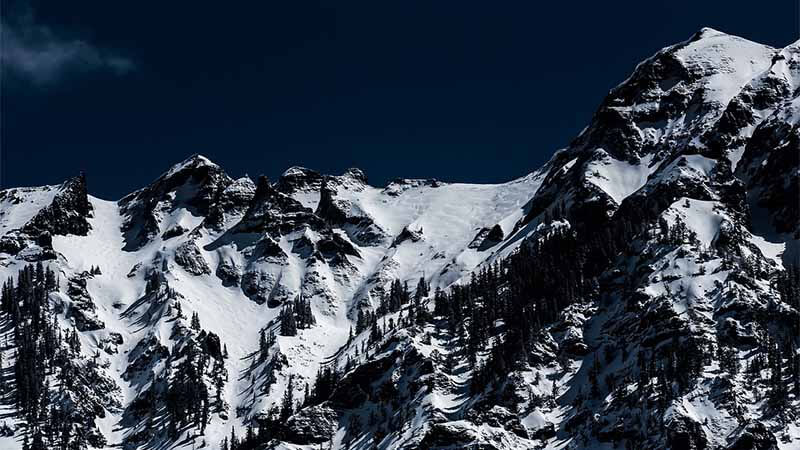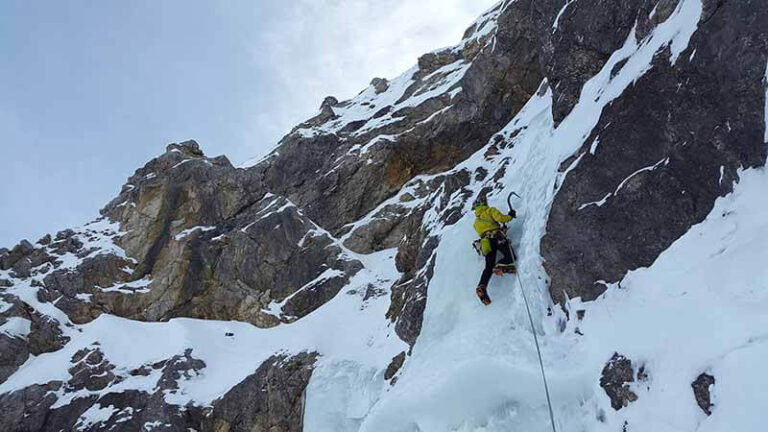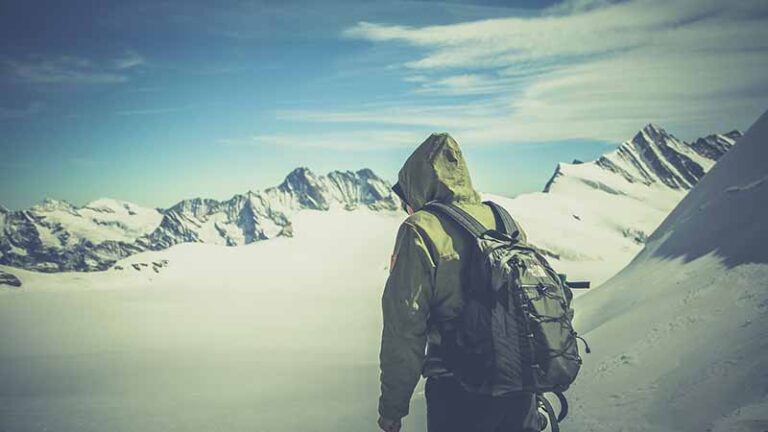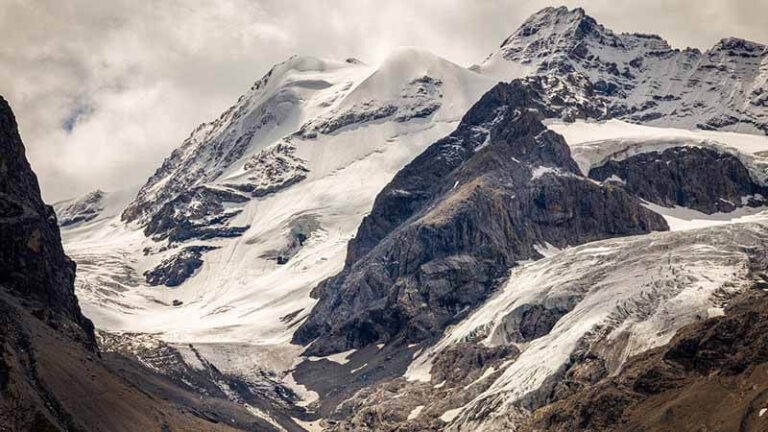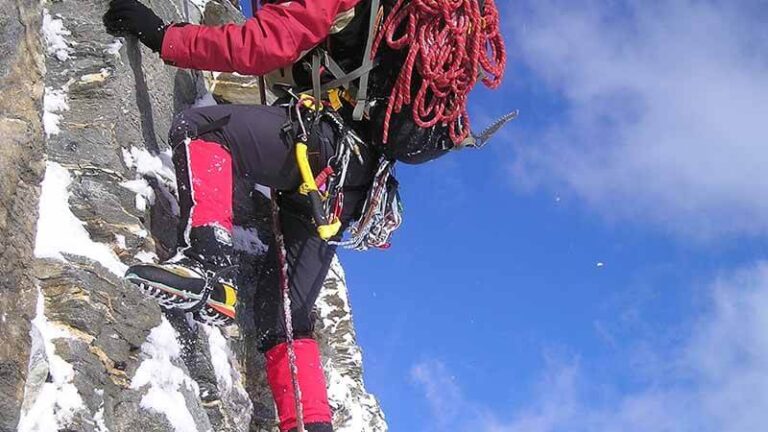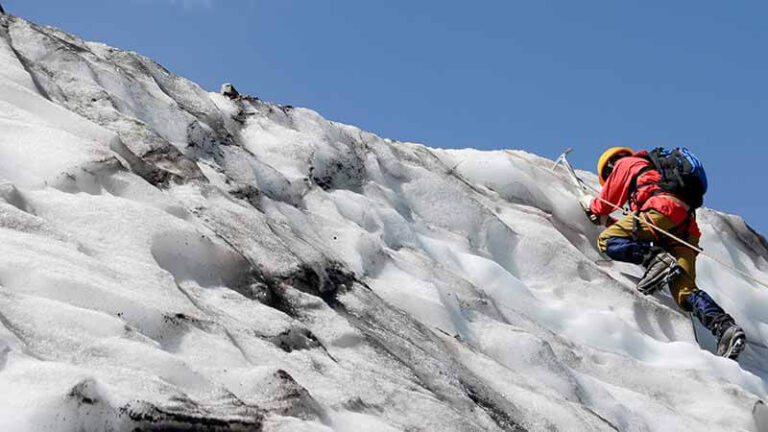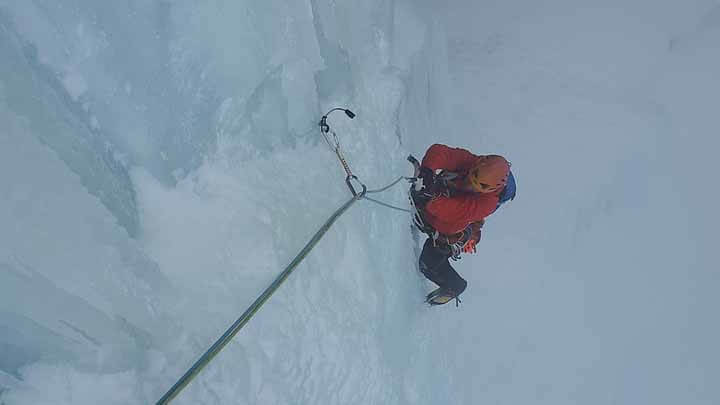Ice Climbing Techniques for Beginners
Ice climbing is a thrilling and difficult outdoor activity that entails mounting frozen waterfalls, ice walls, or glaciers using specialized equipment. The significance of good ice climbing skills cannot be emphasized, as they are critical to the safety, success, and pleasure of this adventurous sport.
To begin with, mastering ice climbing skills is critical for safety. Ice climbing carries inherent risks, such as the possibility of equipment failure, falling ice, avalanches, and harsh weather conditions.
Climbers can avoid these dangers and adapt effectively to unforeseen situations by using proper procedures. Techniques like as precise belaying and efficient ice tool installation lessen the chance of accidents and injuries.
Second, effective climbing tactics are critical for increasing efficiency and conserving energy. Ice climbing requires tremendous physical effort, and inefficient motions can cause premature tiredness, increasing the danger of an accident.
Climbers can save energy for longer, more difficult routes by learning to move effectively on ice, which includes mastering varied footwork and tool placement strategies.
Furthermore, knowing ice climbing skills helps to preserve the climbing environment. Through poor tool placement or excessive effort, inexperienced climbers may unwittingly harm fragile ice formations. Climbers can reduce their influence on fragile ice structures by following best practices, ensuring that these natural treasures remain accessible for future generations.
Finally, ice climbing is about more than just reaching the summit; it is also about self-improvement and personal growth. Proper techniques are the foundation for progress in the sport.
Climbers can tackle progressively challenging routes as they gain expertise, creating and attaining personal goals that are both rewarding and encouraging.
Safety Considerations for Ice Climbing
Ice climbing is an inherently dangerous activity that necessitates close attention to safety precautions to reduce hazards and provide a safe and enjoyable experience. The following are some key safety considerations to keep in mind before beginning an Ice climbing adventure:
- Knowledge and Training: Individuals should get complete training from competent instructors or guides before attempting ice climbing. For beginners, learning proper skills, equipment usage, and safety protocols is critical.
- Equipment Inspection: Inspect and maintain ice climbing equipment such as ice axes, crampons, ropes, and harnesses on a regular basis. Damaged or worn-out equipment might be dangerous during climbs.
- Weather Observation: Keep a close eye on the weather and forecasts. Ice climbing can be dangerous in extreme cold, high winds, or during an avalanche-prone period. Always put safety ahead of the desire to climb.
- Avalanche danger Assessment: When ascending in mountainous areas, estimate the danger of avalanches and carry necessary safety equipment such as avalanche beacons, shovels, and probes. Learn about avalanche terrain and safe routes as well.
- Communication: It is critical to communicate effectively with climbing partners. Establish clear signals and make certain that everyone understands commands and procedures, particularly in noisy or remote situations.
- First Aid Skills: A basic understanding of outdoor first aid is essential. Climbers should be prepared to deal with injuries, frostbite, and hypothermia in a remote location until professional assistance arrives.
- Route Evaluation: Before beginning a climb, thoroughly assess ice conditions, route quality, and potential risks. Prepare to retreat if conditions worsen or the road becomes too dangerous.
- Belaying and Anchoring: Safe belaying and anchoring skills are essential. Check that the anchors are secure and that the belaying devices are properly deployed.
- Prepare a rescue plan and have the appropriate equipment for self-rescue or assisting fellow climbers in the event of an accident or emergency.
- Leave No Trace: Follow the Leave No Trace principles to respect the environment. Reduce your impact on the vulnerable ice and surrounding ecology.
This ice climbing guide is designed for novices who are new to the sport and are looking for a thorough resource to help them get started. This guide is also useful for intermediate climbers who want to improve their skills and obtain a better grasp of Ice climbing tactics.
Essential Gear for Ice Climbing
Ice climbing is a gear-intensive sport, and selecting the appropriate equipment is critical for both safety and success on the ice. In this section, we’ll look at the essential components of ice climbing gear and why choosing the right gear is so important for a good ice climbing experience.
Choosing the Right Ice Climbing Gear
Ice Axes and Tools
Ice axes and tools are the most common tools for holding and ascending ice. They are available in a variety of styles, such as advanced ice tools for steep ice and traditional ice axes for general climbing. The correct tool for the job is determined by the type of ice climb you intend to attempt.
- Technical ice tools are intended for use on steep and vertical ice. They usually have a more forceful pick and an ergonomic design for swinging and hooking on ice characteristics.
- Traditional ice axes are adaptable and ideal for mild ice and diverse terrain. They have a more traditional design and a bent pick for self-arrest.
The ice axe/tool you choose should be appropriate for your skill level and the difficulty of your climbs, with more experienced climbers frequently choosing technical gear for harder ice routes.
Crampons
Crampons are spiky boot additions that provide traction on slippery surfaces. Crampons come in a variety of styles, including step-in and strap-on variants. Consider the sort of footwear you have while selecting crampons, as compatibility is critical.
- Step-In Crampons: These require boots with welts on the front and back. They provide a solid fit and are ideal for tricky ice climbing.
- Strap-On Crampons: These are more versatile and can be worn with a wider variety of boots. They are suitable for ice climbing and mountaineering in general.
Crampons must be correctly installed, adjusted, and maintained to give the essential grip and stability during climbing.
Harness and Helmet
A climbing harness is necessary for safety since it provides attachment places for ropes and gear. Consider comfort, adjustability, and gear loops for carrying equipment while selecting a harness. Assemble it so that it fits snugly but pleasantly around your waist and legs.
A climbing helmet is essential for protecting your head from falling ice, boulders, or gear. Look for an ice climbing helmet with ventilation and customizable features for comfort during climbs.
Clothing and Layering
In chilly and potentially damp weather, proper clothes and layering are critical for maintaining body temperature. Typically, the layering method consists of three layers:
Moisture-wicking and insulating base layer, commonly made of merino wool or synthetic materials to keep you dry.
Insulating Layer: A fleece or down jacket provides warmth.
Wind, rain, and snow are all protected by the outer layer. Ice climbing requires a waterproof and breathable shell.
Wear moisture-wicking socks, insulated gloves, and gaiters to keep your limbs warm and dry.
Properly Maintaining Ice Climbing Equipment
Ice climbing equipment maintenance is critical for safety and longevity. Neglected equipment might result in accidents and pricey replacements. Here are some important ice climbing equipment maintenance tips:
- Regular Inspections: Inspect all gear before each climb for signs of wear, damage, or rust. Keep an eye out for crampon points, ice tool picks, and harness buckles.
- Cleaning: After using your gear in icy conditions, properly rinse and dry it to prevent rust. Crampons and ice tools should be cleaned of dirt and ice.
- Sharpening: For maximum effectiveness, keep ice tool picks and crampon points sharp. As needed, use a file or specialized sharpening tools.
- Storage: Keep your equipment in a cool, dry location away from direct sunlight. Allowing equipment to sit in moist or humid environments might cause corrosion.
- Replace When Necessary: Replace equipment that shows evidence of considerable wear or damage. Investing in fresh equipment is far safer than risking a failure during a climb.
Ice climbers can assure their safety, comfort, and optimum performance while ascending frozen terrain by carefully selecting the right gear and effectively maintaining it.
Always prioritize gear inspection and maintenance to extend the life of your equipment and reduce dangers while ice climbing.
Ice Climbing Fundamentals
Ice climbing is a demanding and dynamic sport that necessitates a strong foundation in a variety of skills and methods. In this section, we’ll go over the fundamentals of ice climbing, such as ice types and grades, basic ice climbing knots, and belaying techniques.
Understanding Ice Types and Grades
Differentiating Between Ice Types
Ice climbing includes a variety of ice formations, each with its own set of qualities and problems. Understanding various varieties of ice is essential for selecting proper climbing tactics and equipment. The following are examples of common ice types:
- Water ice is formed when rushing water freezes and is commonly observed in frozen waterfalls and icefalls. It is dense and somewhat stable, making it ideal for climbing.
- Mountain ice is frequently encountered on glaciers and mountain routes. Its texture ranges from fluffy snow to hard, compacted ice, giving a variety of climbing challenges.
- Mixed Ice Climbs: Mixed ice climbs include rock and ice. Climbers must traverse both mediums, frequently employing specialized mixed climbing equipment.
Grading Systems for Ice Climbs
Ice climbing routes are graded using several grading systems, which tell climbers about the difficulty and danger level of a certain climb. The following are two regularly used grading systems:
- Water Ice Grading: This method is represented by Roman numerals ranging from I to VII, with higher numbers indicating more difficulty. WI2, for example, is simpler than WI4. It also has plus (+) and minus (-) modifiers for more accurate assessments.
- Alpine Ice Grading: Alpine ice routes are assessed using an alpine grading system (e.g., AI1, AI2) that evaluates the whole difficulty of the route, including both ice and mixed terrain.
Understanding these grading systems allows climbers to choose climbs that are appropriate for their ability level and objectives, resulting in a safe and pleasurable experience.
Basic Ice Climbing Knots
- Figure Eight Knot: The figure-eight knot is a basic knot in both ice and rock climbing. It forms a secure loop at the end of a rope and is widely used for tying into a harness and attaching to other climbing equipment. Its dependability and ease of tying make it a must-have safety knot.
- Double Fisherman’s Knot: This knot is used to unite two ropes or to construct a secure loop in the middle of a rope. Ice climbers frequently use it to make prusik loops or to connect two ropes when rappelling or setting up belay anchors.
- Clove Hitch: The clove hitch is a handy belaying and anchoring knot. It’s simple to modify to connect a rope to a carabiner or anchor point. When putting up belay systems or equalizing anchors, ice climbers typically use the clove hitch.
Belaying Techniques for Ice Climbing
Belaying is an important part of ice climbing since it ensures the safety of both the climber and the belayer. Techniques for ice climbing belaying include:
- Top Rope Belaying: The belayer stands at the bottom of the ice climb and manages the rope while the climber ascends. This method is popular among novices because it gives a high level of safety.
- Lead Belaying: In lead belaying, the climber ascends first while setting ice screws or other protection. The belayer manages the rope, providing slack when needed and assuring the safety of the climber.
- Climbers utilize belay devices like the Grigri or ATC to manage rope tension and enable seamless belaying. The proper use of a belay device is critical for preventing falls and managing rope dynamics.
- Communication: It is vital that the climber and belayer communicate effectively. Climbers must utilize unambiguous commands and signals to communicate their activities and demands, and belayers must be alert and responsive.
- Dynamic Belaying: In dynamic belaying, the belayer predicts and adjusts the movement of the rope in order to lessen shock loads during a fall and thereby reduce the danger of injury.
Ice climbing belaying techniques are intended to give climbers a safety net while allowing them to ascend difficult ice routes.
Climbers and belayers must both have proper training and practice in order to have a safe and efficient climbing experience.
Ice Climbing Techniques
Ice climbing techniques are the fundamental abilities that climbers must master in order to safely and efficiently traverse frozen terrain. This section delves into the core methods needed for Ice climbing proficiency.
Body Positioning and Balance
Stance and Weight Distribution
Ice climbing requires a proper stance and weight distribution. To reduce the risk of falling, climbers must maintain a balanced and secure position on the ice. Keep your body close to the ice, align your hips and feet, and distribute your weight evenly between crampons and ice tools.
It is critical to redistribute body weight slightly towards the axes or crampons depending on the terrain when mounting ice. While kicking with crampons, leaning into the ice tools gives a firm footing and reduces the possibility of dislodging ice.
Maintaining Balance on Ice
Ice surfaces can be unpredictable in terms of texture, thickness, and tilt. Climbers must constantly modify their equilibrium in order to adapt to these situations. To maintain stability, techniques such as “flagging” (positioning one foot or hand in a strategic position to counterbalance) and “torquing” (twisting ice tools to get hold) are used.
Kicking and Placing
Proper Ice Tool Placement
Ice tool placement efficiency is a crucial ability in ice climbing. Climbers must learn to precisely swing and place ice tools to ensure they penetrate the ice securely. The angle and force of the swing, as well as the pick placement, determine the tool’s stability.
Depending on the ice conditions and the exact climb, techniques like “hooking” (hooking the pick onto ice features), “tapping” (lightly tapping the ice for stable placement), and “stein pull” (drawing down on the ice tool) are used.
Effective Crampon Techniques
Crampons give the essential traction for ice climbing, and they must be used correctly. Climbers must kick their crampons into the ice with control, ensuring that all points engage securely.
“Front-pointing” (using the front points of crampons on steep ice), “flat-footing” (using the entire crampon platform on less steep terrain), and “heel hooking” (using the crampon’s heel to hook onto ice features) are all techniques. Proper technique reduces the likelihood of slipping and increases confidence on the ice.
Movement on Steep Ice
Front-Pointing
A basic technique for ascending steep ice is front-pointing. It entails kicking into the ice with the front points of crampons to create a secure anchor point. Climbers must keep a rhythm and kick with each foot alternately. Front-pointing is useful for dealing with vertical and near-vertical ice walls.
French approach
When transitioning between portions of differing ice angles or on less steep terrain, the French approach is used. Climbers use this method to stand more erect, employing the front and sometimes secondary points of crampons for balance and support.
American approach
The American approach contains features of both the French and front-pointing techniques. Climbers use the front points for stability while also smearing or gaining additional grip on the secondary points. This adaptable method is suitable for a variety of ice conditions.
Efficient Resting and Recovery
Using Ice Screws for Anchors
Climbers can rest and recover during ascents by using ice screws as temporary anchors. It is critical to place and equalize ice screws correctly for safety. Climbers can utilize slings or leashes attached to the screws as handholds or to relieve weight off their arms.
Resting Positions
Resting effectively is critical for preserving energy during ice climbs. Climbers can take brief pauses in ice features such as ledges or hollows. Techniques such as “knee bars” (using the knee to wedge into a fissure), “dagger rests” (supporting the ice tool shaft with a ledge), and “hanging rests” (hanging from ice tool placements) allow for recovery without jeopardizing safety.
These Ice climbing skills are the foundation for success in this tough sport. Climbers must develop a solid foundation in body positioning, tool and crampon placement, mobility, and resting strategies in order to navigate difficult ice routes safely and successfully. For developing these skills, practice, experience, and instruction from experienced climbers and instructors are essential.
Safety Measures
Because of the inherent dangers of the activity, safety is of the utmost importance in ice climbing. Climbers must follow a set of safety procedures and standards to ensure a safe and enjoyable experience. In this section, we’ll look at five key components of ice climbing safety.
Assessing Ice Conditions
The first and most important safety safeguard in ice climbing is assessing ice conditions. Before beginning a climb, climbers must thoroughly assess the quality and stability of the ice.
Ice thickness, structure, color, and any visible indicators of fragility or cracking are all important factors to examine. Ice screws are frequently used by experienced climbers to measure the thickness of the ice at various locations along the route.
It is also necessary to understand the local climate and recent weather patterns. Climbers should be informed of current weather conditions and forecasts because sudden temperature fluctuations might impair ice stability.
Ice climbing guidebooks and local climbing communities are excellent sources of current ice conditions in specific places.
Avalanche Awareness
Avalanches are a major problem in mountainous areas where ice climbing is popular. Climbers should receive avalanche safety training and become familiar with avalanche risk factors. Avalanche safety precautions include:
- Avalanche Forecast: Before venturing out, check avalanche forecasts and bulletins to determine the current risk level in the area.
- Terrain Evaluation: Recognizing and avoiding avalanche terrain features such as slopes, couloirs, and cornices that are prone to avalanches.
- Avalanche Safety Gear: Having critical avalanche safety equipment on hand, such as transceivers, shovels, and probes, and understanding how to utilize it for rescue.
- Traveling One at a Time: When climbing in avalanche-prone terrain, climbers should ascend and descend one at a time to reduce the possibility of many people being caught in an avalanche.
Communication with Climbing Partners
Communication between climbing partners is essential for safety. Climbers should develop a clear system of verbal and nonverbal communication in order to communicate their intents and demands. This includes the following:
- Commands: Use standardized commands like “on belay,” “climbing,” “slack,” and “off belay” to coordinate rope management and ensure synchronized belaying.
- Signals: Using hand signals or agreed-upon motions for communication when spoken communication is difficult due to distance, noise, or inclement weather.
- Check-ins: Check in with climbing partners on a regular basis to assess their physical and mental well-being and address any concerns or issues.
- Emergency Protocols: Discussing and practicing emergency protocols, such as what to do in the event of a fall or injury, in order to guarantee a quick and coordinated response.
Recognizing Signs of Frostbite and Hypothermia
Climbing in cold, icy conditions puts climbers in danger of frostbite and hypothermia. Knowing how to spot the early warning signals of certain cold-related injuries is critical:
- Frostbite: Symptoms include numbness, tingling, and pale or discolored skin, which commonly begins in the extremities such as fingers, toes, ears, and nose. It is critical to rewarm quickly using body heat or warm water.
- Hypothermia: Shivering, disorientation, slurred speech, and excessive weariness are all symptoms of hypothermia. Hypothermia can be treated by removing damp clothing, providing warm fluids, and huddling for warmth. Severe instances necessitate prompt medical treatment.
Climbers should dress in layers and stay dry and warm to avoid these situations. Recognizing and managing these symptoms in oneself and climbing partners is a critical safety measure.
Self-Rescue Techniques
Climbers on ice may occasionally find themselves in difficult positions requiring self-rescue skills. Some key self-rescue tactics are as follows:
- Prusik Knots: Using prusik loops to ascend or descend a rope when necessary, such as after a fall or during rappelling.
- Ice Screw Anchors: Understanding how to safely install ice screws to build anchors for belaying, rappelling, or self-rescue.
- Escaping the Belay: Climbers should understand how to escape the Belay system and secure themselves if the Belay becomes incapacitated.
- Rappelling Safely: Competence in rappelling procedures, including rappel anchor setup and safe rope descent.
Climbers should receive sufficient training in these self-rescue techniques and practice them on a regular basis to maintain emergency readiness.
Training and Preparation
Training and preparation are essential components of ice climbing, a physically, mentally, and technically demanding sport. In this section, we’ll look at the most important aspects of ice climbing training and preparation.
Physical Conditioning for Ice Climbing
Ice climbers must train physically to develop the strength, endurance, and agility required for the sport’s unique demands. Here are some fundamental factors of ice climbing physical conditioning:
- Strength Training: Ice climbing requires upper body strength to grip ice tools and grip holds. Climbers can focus on arm and back strength exercises such as pull-ups, deadlifts, and rows.
- Core Strength: On the ice, a strong core promotes stability and balance. Planks and leg lifts are crucial core exercises.
- Cardiovascular Endurance: Climbing in the cold can be physically demanding. Aerobic fitness, which can be obtained through sports such as jogging or cycling, aids in endurance during long climbs.
- Flexibility: Reaching grips or hooks on ice typically necessitates contorting the body. Stretching exercises increase flexibility, which helps with body placement on the ice.
- Balance and Coordination: Yoga and slacklining can help improve balance and coordination, which are important qualities for ice climbing.
- Specific Training: Dry-tooling (climbing with ice tools on rock) or indoor ice climbing walls assist in creating sport-specific strength and technique.
A well-rounded physical conditioning program guarantees that climbers are physically healthy enough to meet the demands of ice climbing.
Mental Preparedness
Mental preparation is equally important in ice climbing. Climbers frequently confront intense temperatures, exposure to heights, and difficult technical terrain, all of which can be mentally exhausting. Mental readiness involves the following elements:
- Mental Toughness: Developing resilience in order to face physical and mental hurdles on the ice. Climbers can stay focused and motivated by using visualization techniques and positive self-talk.
- Fear Management: Recognizing and managing fear is essential. Fear can be an effective self-preservation technique, but it should not immobilize a climber. It is critical to learn to distinguish between rational fear and irrational anxiety.
- Making Decisions: Mental readiness includes making sound decisions, such as understanding when to turn back due to deteriorating weather. Climbers must avoid summit fever and emphasize safety above all else.
- Stress Management: Because ice climbing can be stressful, climbers should have stress and anxiety management tools in place, such as mindfulness, relaxation techniques, or controlled breathing.
- Risk understanding: A mentally prepared climber recognizes and respects the inherent risks of ice climbing, and this understanding guides their actions and decisions.
Finding a Mentor or Guide
Finding a mentor or hiring a trained climbing guide is highly advised for novices. A mentor or guide can provide vital experience and assistance, speeding up the learning process and assuring safety. Mentors and guides can help with training and preparation in the following ways:
- Technical Instruction: They educate students on proper ice climbing methods such as tool and crampon placement, belaying, and rope management.
- Route Selection: Guides can assist climbers in selecting acceptable routes based on their skill level and provide essential information about local ice conditions.
- Safety Education: Mentors and guides emphasize safety rules and measures, assisting climbers in developing safe habits from the start.
- Coaching and feedback: They provide constructive criticism, assisting climbers in refining their skills and improving their climbing technique.
- Emergency Response: Instructors prepare climbers for possible crises by teaching self-rescue and first-aid practices.
Practice and Skill Development
Ice climbing skill improvement relies heavily on practice. Climbers should constantly improve their abilities through focused practice. This includes the following:
- Frequent Climbing: Frequent climbing is crucial for skill improvement. Indoor ice climbing walls, dry-tooling, and local ice climbing places provide plenty of practice options.
- Progressive Climbing: Climbers should go from easier to more difficult routes, acquiring abilities and confidence along the way.
- Consistency: Climbing on a regular basis helps to maintain abilities sharp and muscles.
- Technical Work: Concentrating on certain technical areas such as footwork, tool placement, and belaying techniques might help you develop your skills faster.
- Climbing Community: Participating in the climbing community allows you to learn from others, share experiences, and get insights.
Where to Ice Climb
Ice climbing is an exciting adventure activity that brings climbers to some of nature’s most stunning and difficult landscapes. In this section, we’ll look at popular ice climbing places across the world, each with its own distinct mix of ice formations, breathtaking landscapes, and climbing opportunities.
Popular Ice Climbing Destinations
Ouray, Colorado, USA
Ouray, sometimes known as the “Switzerland of America,” is a top ice climbing destination in the United States. It has a plethora of ice routes in the Uncompahgre Gorge, including the famous Ouray Ice Park, which has hundreds of ice and mixed climbs. The park’s man-made ice walls, fed by a natural hot spring, are ideal for both novice and experienced climbers.
Banff National Park, Canada
Banff National Park, located in the Canadian Rockies, has some of the most beautiful ice climbing routes in North America. Popular climbing places such as Johnston Canyon and Lake Louise provide a diverse choice of ice climbs for all skill levels. The breathtaking scenery of ice waterfalls and towering peaks adds to this destination’s attractiveness.
Chamonix-Mont-Blanc, France
Chamonix, located in the French Alps, is well-known for its mountaineering and ice climbing. The location has a variety of ice routes, including difficult climbs such as the “Super Couloir” and “Cascade du Trient” for experienced climbers. Chamonix serves as a climbing center and provides access to some of the world’s most spectacular alpine terrain.
Rjukan, Norway
Rjukan is well-known for its frozen waterfalls and is known as the “Ice Climbing Capital of Norway.” The area has a large network of ice routes of varied difficulty levels. Climbers are lured to the surreal splendor of the ice formations in Rjukan’s narrow gorges and valleys.
Squamish, British Columbia, Canada
While Squamish is well renowned for rock climbing, it also has excellent ice climbing options in the winter. The Sea-to-Sky Highway and Shannon Falls, for example, offer accessible ice climbs against a backdrop of raw coastal splendor.
Hyalite Canyon, Montana, USA
Hyalite Canyon, located just outside of Bozeman, Montana, offers a diverse choice of ice climbing routes in a pristine natural setting. The location is especially popular for its consistent ice conditions and options for both novice and experienced climbers.
Swiss Alps, Switzerland
The Swiss Alps are an ice climber’s heaven, with a profusion of frozen waterfalls and ice structures. Climbers seeking alpine ice adventures will find various terrains and stunning vistas at destinations such as the Aletsch Glacier and the Val d’Anniviers.
Alpental Valley, Washington, USA
Alpental Valley, located near Seattle, Washington, offers easy access to ice climbing in the Pacific Northwest. In a spectacular alpine backdrop, the location offers a combination of ice and mixed climbing routes.
Cogne, Italy
Cogne, in the Italian Alps’ Aosta Valley, is famous for its high-quality ice climbs. Climbers are lured to the steep and difficult routes available in the area’s beautiful valleys.
Catskills, New York, USA
The Catskills provide accessible ice climbing possibilities for climbers in the northeastern United States. The area’s ice waterfalls and gullies offer a variety of climbing opportunities for climbers of all skill levels.
These prominent ice climbing locations are only a taste of the vast and diverse world of ice climbing. Each location has its own distinct blend of ice formations, natural beauty, and climbing obstacles, making it a popular destination for ice climbers from all over the world.
Whether you’re a novice or a seasoned climber, there’s an ice climbing destination to suit your interests and skill level, giving you a once-in-a-lifetime adventure in some of the most breathtaking settings on the planet.
Conclusion
Finally, starting on an ice climbing adventure can be a life-changing experience. It’s more than a sport; it’s an adventure that takes you into the heart of some of the world’s most spectacular and remote locations.
The exhilaration of ascending frozen waterfalls, the camaraderie of the climbing community, and the sense of accomplishment that comes with completing difficult routes all contribute to what makes ice climbing so remarkable.
We provide words of encouragement to individuals who are thinking about taking their first steps into the realm of ice climbing. It’s a journey that will push your physical and mental limitations while rewarding you with breathtaking views and a sense of success like no other.
Begin with the fundamentals, seek out skilled mentors or guides, and devote time to mastering the necessary skills and procedures. As your confidence grows, you’ll find yourself reaching new heights on the ice and within yourself.

